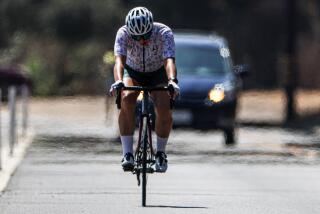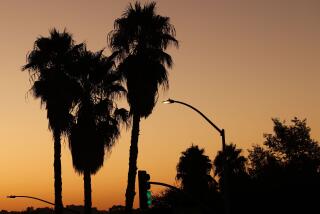Water, Electricity Use Soar With Mercury; Some Relief in Sight
- Share via
San Diego’s record April heat wave will dissipate over the weekend, the National Weather Service predicts, but the consistent soaring temperatures have taken their toll on San Diego County, sending electricity use skyrocketing and forcing county water officials to issue a first-stage water-shortage alert.
“The heat wave will gradually go away on the weekend,” said Weather Service meteorologist Wilbur Shigehara. “For the coastal section, temperatures will be moderate enough that, by Saturday, we’ll drop the heat advisory.” For the inland areas, however, the heat advisory will continue through the weekend, he said.
A record-breaking 93 degrees was recorded at Lindbergh Field Friday. That was 8 degrees higher than the previous record of 85, reached in 1962. The consistent high temperatures are “unprecedented since 1872,” Shigehara said. “It’s gotten up to 90 and higher only 17 times in April since 1872, and never four consecutive days.”
Beaches Cooling Off
For the weekend, the beaches will be the coolest areas, with temperatures in the 70s, and the mercury for inland areas will dip below 100 by Sunday, Shigehara said.
The intense heat has caused customers to use massive quantities of water in the last few days, causing a shortage, said Henry Pepper, assistant water utilities director for San Diego. The County Water Authority has announced a water alert to all of its member agencies, including the city of San Diego.
“There is a Stage 1 water alert beginning (Friday) afternoon and lasting through the hot spell,” Pepper said. San Diegans used a record 275 million gallons of water Thursday. The average is 208 million gallons a day. During the summer months, the average is 250 million gallons, Pepper said.
The County Water Authority is asking that residents limit all outdoor use of water to between 6 p.m. and 6 a.m., including outdoor irrigation, refilling pools and spas and washing cars. Residents are also being encouraged not to hose down sidewalks, patios and other paved areas, and restaurants are being asked to serve water only upon request. Some areas may experience low water pressure, but the agency is adjusting distribution to accommodate the high demand.
Electricity consumption also reached a record high Thursday, said Tom Murnane, media communications representative at San Diego Gas & Electric. “One megawatt on an average day is enough to supply 1,000 people in our service territory with energy. This time of year, usually the demand is at 2,000 megawatts. At 3:30 p.m., it reached 2,694 megawatts,” he said of Thurday’s record.
Murnane said he doesn’t expect a problem meeting electricity demands this weekend, since more electric ity is used during the week.
The heat has also taken a big toll on San Diego’s fragile strawberry crop, said Kathleen Thuner, commissioner of the San Diego County department of agriculture, and customers can soon expect to see significantly higher prices in stores.
“Our understanding is that there is between a 30% to 60% loss in the strawberry crop, depending on the location. Fallbrook and Bonsall are the worst,” she said. “In the first stages, there is the loss of berries on the plant. Now what we’re seeing happen is the flowers are literally being burned off the plant and the leaves, too, are showing damage. If the heat continues, there will be even further damage.”
Although there are no definite figures on the monetary loss, Thuner said 50% of the strawberry crop usually amounts to sales of $7-$10 million.
Other Crops Affected
The avocados and citrus crops are also losing their blossoms, but, since there is a period of almost a year between the bloom and the harvest, “it’s hard to guess what that loss would be,” Thuner said.
In the desert areas, where temperatures have been highest, the low humidity has strongly contributed to explosive fire danger, Shigehara warned.
There were some spot fires in Dehesa and Valley Center on Wednesday and Thursday, said Capt. Charles Howell of the Department of Forestry. “We’re planning on keeping a skeleton crew on weekend duty and we don’t normally do that,” he said.
“We had some fires up to 100 acres last weekend in Julian, and some spots here and there,” Howell said. “They’re just brush fires, but, if they get going, there’s a threat out there. They can grow very fast, with the dry weather and the wind.”
In the East County, where temperatures have been among the highest, school officials in the Grossmont Union High district continued to close schools early. Although the students like it, “some of the parents don’t,” said Rose Hanson, switchboard operator for the district.
Students of Grossmont, El Cajon, Mt. Miguel and Granite Hills high schools will be released from classes between 12:30 and 1:30 p.m. until the weather cools off, said Pat Stout, a clerk in the superintendent’s office. “They’re in the heart of the heat,” she said.
In spite of the soaring temperatures, most area hospitals reported relatively few incidents of heat exhaustion. “Yesterday we expected a whole bunch, and we usually do (have heat exhaustion patients), but this time we didn’t,” said Paula Simpkins, a nurse at San Diego Physicians & Surgeons Hospital.
To avoid heat exhaustion, Simpkins suggests wearing cool, protective clothing, drinking plenty of water and not overdoing it. “Don’t drink alcohol in the sun,” she added. “It’s a diuretic. It dehydrates you, and you get heat exhaustion 10 times quicker.”
In downtown San Diego, the hordes of homeless who normally gather downtown in front of Horton Plaza dwindled as most went in search of shade. “They find shade somewhere, off the beaten path,” said Mark Odoms, a self-described “professional outdoorsman.”
More to Read
Sign up for Essential California
The most important California stories and recommendations in your inbox every morning.
You may occasionally receive promotional content from the Los Angeles Times.













